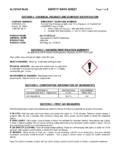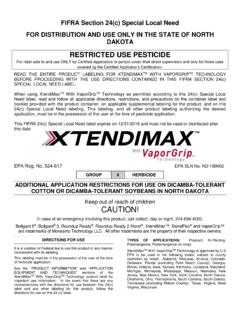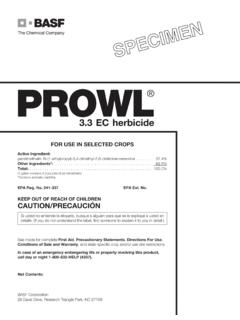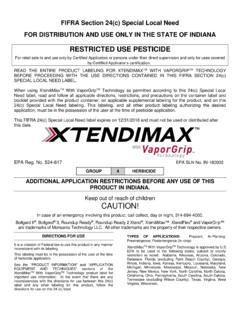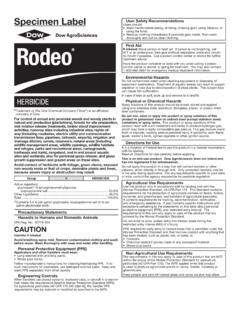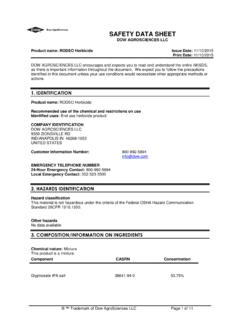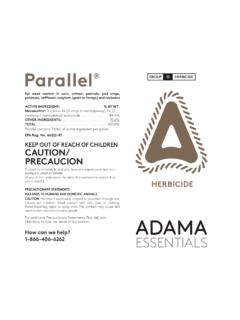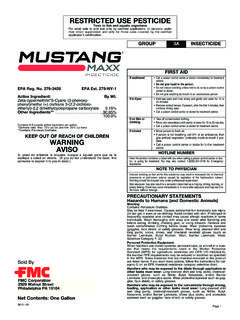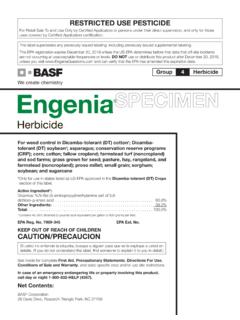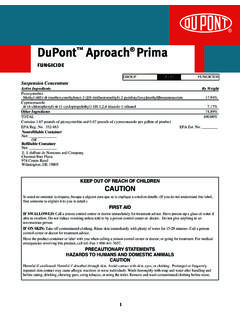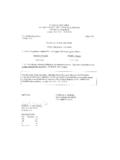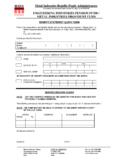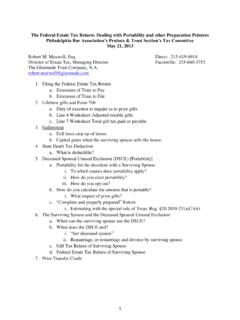Transcription of Product Name: SureGuard® SC Herbicide EPA Reg. No ...
1 SAFETY DATA SHEET SureGuard SC Herbicide 1. CHEMICAL Product AND company IDENTIFICATION. Product Name: SureGuard SC Herbicide EPA Reg. No.: 71368-114. Product Type: Herbicide company Name: Nufarm Americas Inc 11901 S. Austin Avenue Alsip, IL 60803. 1-800-345-3330. Telephone Numbers: For Chemical Emergency, Spill, Leak, Fire, Exposure, or Accident, Call CHEMTREC Day or Night: 1-800-424-9300. For Medical Emergencies Only, Call 1-877-325-1840. This Product is an EPA FIFRA registered pesticide. Some classifications on this SDS are not exactly the same as on the FIFRA label. Certain sections are superseded by federal law governed by EPA for a registered pesticide. Please see Section 15. REGULATORY INFORMATION for explanation. 2. HAZARDS IDENTIFICATION. PHYSICAL HAZARDS: Not Hazardous HEALTH HAZARDS: Not Hazardous ENVIRONMENTAL HAZARDS: Hazardous to aquatic environment, acute Category 1. Hazardous to aquatic environment, chronic Category 1.
2 SIGNAL WORD. No Signal Word HAZARD STATEMENTS. Very toxic to aquatic life with long-lasting effects. PRECAUTIONARY STATEMENTS. Avoid unintended release to the environment. Collect spillage. Dispose of contents and container in accordance with local, state and federal regulations. 3. COMPOSITION / INFORMATION ON INGREDIENTS. COMPONENTS CAS NO. % BY WEIGHT. Flumioxazin 103361-09-7 Propylene Glycol 57-55-6 Other Ingredients Trade Secret Trade Secret Synonyms: 2-[7-fluoro-3,4-dihydro-3-oxo-4-(2-propy nyl)-2H-1,4-benzoxazin-6-yl]-4,5,6,7-tet rahydro-1H- isoindole-1,3(2H)-dione Ingredients not precisely identified are proprietary or non-hazardous. Values are not Product specifications. May 3, 2016 Page 1 of 6. SAFETY DATA SHEET SureGuard SC Herbicide 4. FIRST AID MEASURES. If Swallowed: Do not give any liquid to the person. Do not induce vomiting unless told to do so by the poison control center or doctor. Do not give anything by mouth to an unconscious person.
3 If symptoms develop, get medical advice. If in Eyes: Hold eye open and rinse slowly and gently with water for several minutes. Remove contact lenses, if present, after the first 5 minutes, then continue rinsing eye. Get medical attention if irritation persists. If on Skin or Clothing: Take off contaminated clothing. Wash with soap and water. Get medical attention if irritation or symptoms develop. If Inhaled: Move person to fresh air. If symptoms develop, get medical advice. Most Important symptoms/effects, acute and delayed: Skin exposure may cause slight irritation. May cause mild eye irritation. Indication of Immediate medical attention and special treatment if needed: None expected. 5. FIRE FIGHTING MEASURES. Extinguishing Media: Use extinguishing media suitable for surrounding materials. Dry chemical, carbon dioxide, foam, water spray or fog. Special Fire Fighting Procedures: Firefighters should wear NIOSH approved self-contained breathing apparatus and full fire-fighting turn out gear.
4 Dike area to prevent runoff and contamination of water sources. Dispose of fire control water later. Unusual Fire and Explosion Hazards: If water is used to fight fire, contain runoff, using dikes to prevent contamination of water supplies. Dispose of fire control water later. Hazardous Decomposition Materials (Under Fire Conditions): May produce gases such as fluorine compounds, and oxides of carbon and nitrogen. 6. ACCIDENTAL RELEASE MEASURES. Personal Precautions: Wear appropriate protective gear for the situation. See Personal Protection information in Section 8. Environmental Precautions: Prevent material from entering public sewer systems or any waterways. Do not flush to drain. Large spills to soil or similar surfaces may necessitate removal of topsoil. The affected area should be removed and placed in an appropriate container for disposal. Methods for Containment: Dike spill using absorbent or impervious materials such as earth, sand or clay.
5 Collect and contain contaminated absorbent and dike material for disposal. Methods for Cleanup and Disposal: Pump free liquid into an appropriate container. Absorb residual with inert absorbent material. Wash entire spill area with a detergent slurry, absorb and sweep into container for disposal. Decontaminate tools and equipment following cleanup. See Section 13: DISPOSAL CONSIDERATIONS for more information. Other Information: Large spills may be reportable to the National Response Center (800-424-8802) and to state and/or local agencies. 7. HANDLING AND STORAGE. HANDLING: Avoid contact with skin, eyes or clothing. Do not breathe spray mist or vapors. Users should wash hands before eating, drinking, chewing gum, using tobacco, or using the toilet. Remove clothing/Personal Protective Equipment (PPE) immediately if pesticide gets inside. Then wash thoroughly and put on clean clothing. Remove PPE. immediately after handling this Product .
6 Wash the outside of gloves before removing. As soon as possible, wash thoroughly and change into clean clothing. STORAGE: Keep pesticide in original container. Store in a cool, dry, secure place. Do not put formulation or dilute spray solution into food or drink containers. Do not contaminate food or foodstuffs. Do not store or transport near feed or food. Not for use or storage in or around the home. For help with any spill, leak, fire or exposure involving this material, call day or night CHEMTREC (800) 424-9300. Do not contaminate other pesticides, fertilizers, water, food or feed by storage or disposal. 8. EXPOSURE CONTROLS / PERSONAL PROTECTION. Engineering Controls: Where engineering controls are indicated by specific use conditions or a potential for excessive exposure, use local exhaust ventilation at the point of generation. May 3, 2016 Page 2 of 6. SAFETY DATA SHEET SureGuard SC Herbicide Personal Protective Equipment: Eye/Face Protection: To avoid contact with eyes, wear goggles or safety glasses.
7 Skin Protection: To avoid contact with skin wear long-sleeved shirt and long pants, shoes plus socks, and chemical-resistant gloves made of any waterproof material. Washing facilities should be readily accessible to the work area. Respiratory Protection: Not normally required. If vapors or mists or dusts exceed acceptable levels, wear NIOSH. approved air-purifying respirator with cartridges/canisters approved for use against pesticides. General Hygiene Considerations: Personal hygiene is an important work practice exposure control measure and the following general measures should be taken when working with or handling this material: 1) do not store, use and/or consume foods, beverages, tobacco products, or cosmetics in areas where this material is stored; 2) wash hands and face carefully before eating, drinking, using tobacco, applying cosmetics or using the toilet. Exposure Guidelines: OSHA ACGIH. Component TWA STEL TWA STEL Unit Flumioxazin NE NE NE NE.
8 Propylene Glycol 10 (WEEL) NE NE NE mg/m3. NE = Not Established 9. PHYSICAL AND CHEMICAL PROPERTIES. Appearance: Off white/milky liquid Odor: Moderately sour Odor threshold: No data available pH: (1% w/w dispersion in DIW @ 25 C). Melting point/freezing point: No data available Initial boiling point and boiling range No data available Flash point: Aqueous composition; >212 F (>100 C). Evaporation rate: No data available Flammability: No data available Upper/lower flammability or explosive limits: No data available Vapor pressure: No data available Vapor density: No data available Relative density: g/mL @ 24 C. Solubility(ies): No data available Partition coefficient: n-octanol/water: No data available Autoignition temperature: No data available Decomposition temperature: No data available Viscosity: cPs @ 24 C; cPs @ 42 C. (50 RPM, Brookfield). Note: Physical data are typical values, but may vary from sample to sample.
9 A typical value should not be construed as a guaranteed analysis or as a specification. 10. STABILITY AND REACTIVITY. Reactivity: Not reactive Chemical Stability: This material is stable under normal handling and storage conditions. Possibility of Hazardous Reactions: Hazardous polymerization will not occur. Conditions to Avoid: Excessive heat. Do not store near heat or flame. Incompatible Materials: Strong oxidizing agents, such as chlorates, nitrates, and peroxides. Hazardous Decomposition Products: Under fire conditions, may produce gases such as fluorine compounds, and oxides of carbon and nitrogen. 11. TOXICOLOGICAL INFORMATION. Likely Routes of Exposure: Inhalation, Skin contact, Eye contact Eye Contact: May cause mild irritation. Non-irritating to the eye based on toxicity studies. Skin Contact: May cause mild irritation on prolonged or repeated exposure. Non-irritating to slight/mild irritation to the skin based on toxicity studies.
10 Ingestion: May be harmful if swallowed in large amounts. Low toxicity if ingested. Inhalation: May cause minor irritation to the respiratory tract. Low toxicity if inhale Symptoms of Exposure: None expected. May 3, 2016 Page 3 of 6. SAFETY DATA SHEET SureGuard SC Herbicide Delayed, immediate and chronic effects of exposure: Adverse effects observed in animals exposed to high doses of flumioxazin technical for long periods of time included effects on blood, liver and kidney. Toxicological Data: Data from laboratory studies conducted are summarized below: Oral: Rat LD50: > 5,000 mg/kg (female). Dermal: Rat LD50: >5,000 mg/kg Inhalation: Rat 4-hr LC50: > mg/L (No mortality at highest dose tested). Eye Irritation: Rabbit: Non-irritating Skin Irritation: Rabbit: Slightly irritating (PDII= ). Skin Sensitization: Not a contact sensitizer in the Local Lymph Node Assay (LLNA) in Mice. Subchronic (Target Organ) Effects: Compound related effects of Flumioxazin Technical noted in rats following subchronic exposures at high dose levels were hematotoxicity including anemia, and increases in liver, spleen, heart, kidney and thyroid weights.
